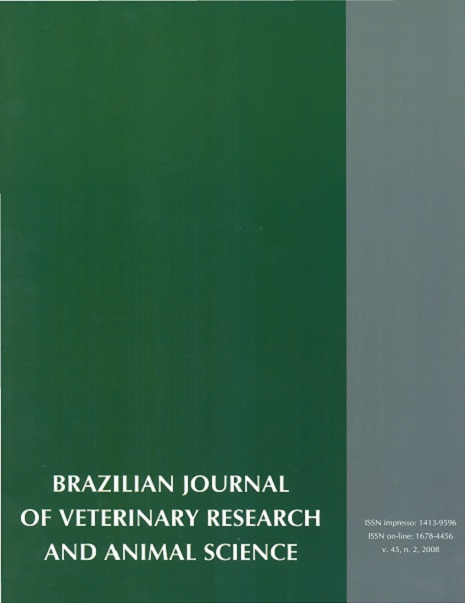Tension loss of a bovine calcaneus tendons
DOI:
https://doi.org/10.11606/issn.1678-4456.bjvras.2008.26707Keywords:
Surgery veterinary, Tendons, Graft, Anterior cruciate ligamentAbstract
Lesion of the anterior cruciate ligament (ACL) in the knee is a problem that affects animals as well as humans and may evolve with joint instability that is often symptomatic and incapacitating. The main option for ligament substitution is the autologous tendon graft. The graft undergoes tensioning during ACL reconstructive surgery to reestablish the normal laxity of the ACL- deficient knee. Although graft tensioning plays a fundamental role in postoperative clinical evolution, ideal tensioning levels have not been established in the literature. Therefore, graft elongation that may occur over time is still one of the main reasons for ligament reconstruction failure. In this study, ten bovine calcaneus tendons underwent two successive assays of physiological tensioning for a maximum deformation of 2.5% of the initial tendon length, maintained for 600s with force (N) values recorded at zero time (initial), 300s and 600s. At the end of the first assay, the tendon returned to its initial length and was maintained at rest for 300s and then the next tensioning assay was initiated, repeating the previous procedure. Statistical analysis revealed that tendon elongation is more pronounced during the initial 300s, reflecting a more accentuated decline in the tension values of the graft. Therefore, 300s after tensioning and fixing the graft, the surgeon can assess with more precision if the tensioning level was adequate.Downloads
Download data is not yet available.
Downloads
Published
2008-04-01
Issue
Section
UNDEFINIED
License
The journal content is authorized under the Creative Commons BY-NC-SA license (summary of the license: https://
How to Cite
1.
Piedade SR, Rodrigues S, Piedade ACTR, Mischan MM, Fabbro IMD. Tension loss of a bovine calcaneus tendons. Braz. J. Vet. Res. Anim. Sci. [Internet]. 2008 Apr. 1 [cited 2026 Jan. 3];45(2):109-15. Available from: https://revistas.usp.br/bjvras/article/view/26707





